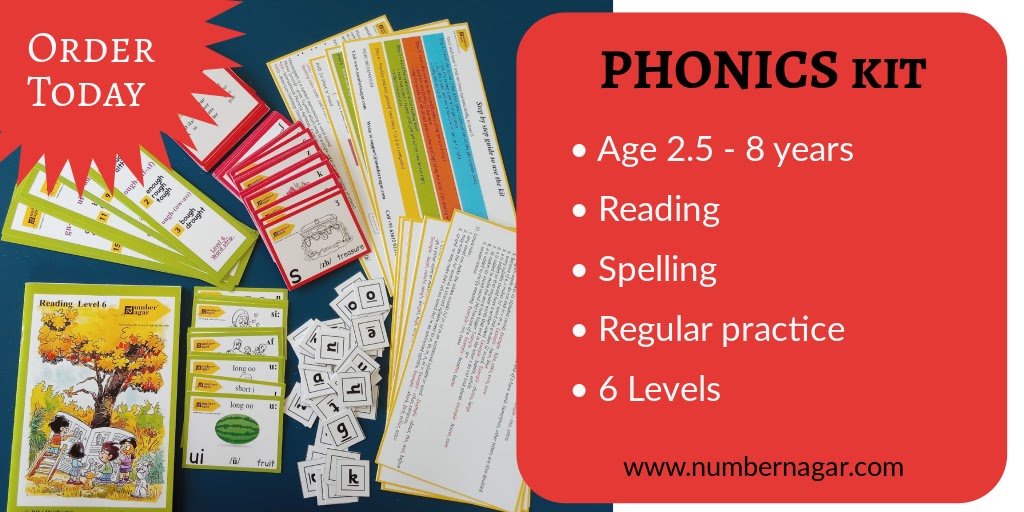Spelling is confusing
Learning English spelling is not straightforward. It is confusing to learn and remember all the spelling rules. After spending many years with the English language as a student and professional, I use the language intuitively. If you ask me to explain a spelling rule, I will have to go back and study.
That is the reason why the experience of the Research, Design, Development of NumberNagar® Phonics programme and kit has been so enlightening. I have unlearned and relearned so many aspects of the English language. It is even more interesting when we teach young children, their curiosity and questions inspire us to strengthen our own basic understanding.
There is no doubt that I have thoroughly enjoyed this journey and continue to do so. In this article, I present to you 2 spelling rules that were new to me. You might find them new and interesting too.
Rule 1
In English words, two ‘i’ s do not appear next to each other.
Did you know this rule before? What do you think of it? It is not evident for regular English users as well. There are but a few words that would have two ‘i’ s next to each other. If you know such a word, then the origin of that word would be from one of the other Indo-European languages or other languages around the world. Let us look at some examples.
- radii – plural of radius – the distance from the centre to the circumference of a circle origin from Latin
- genii – plural of genie (origin from French) and genius (origin from Latin)
- congii – plural of congius – an ancient Roman measurement unit – origin from Latin
- skiing – the action of travelling on snow with skis – ski – origin from Norwegian
- coniine – poison from hemlock plant – origin from Latin
- shiitake – a kind of edible mushroom – origin from Japanese
- tholeiite – a kind of basaltic rock – origin from the name of a German village
Rule 2
English words do not end with i, u, v, or j.
This spelling rule sounds quite dramatic on first encounter. Yet, it is true. Can you think of words ending with these letters? Again, this rule is based on the origin of the word. Let us look at some examples.
Ending with i
- qi – life force – origin from Chinese (Mandarin)
- kiwi – flightless bird from New Zealand – origin from Maori
- nazi – concerning Nazism – origin from German
- rabbi – a Jewish scholar – origin from Hebrew
- safari – an expedition – origin from Kiswahili and Arabic
- alkali – a compound with specific chemical properties – origin from medieval Latin and Arabic
- tsunami – a long and high sea wave – origin from Japanese
- panini – a kind of sandwich – origin from Italian
Ending with u
- emu – flightless bird found in Australia – origin from Portuguese
- menu – a list of dishes – origin from French
- guru – an influential teacher – origin from Sanskrit
- bureau – a piece of furniture or an office/department – origin from French
- plateau – a level high ground area – origin from French
Ending with v
- lev – currency of Bulgaria – origin from Bulgarian
- shiv – a crude knife (informal American) – origin probably from Romani
- moshav – a cooperative association of Israelis – origin from Hebrew
Ending with j
- taj – a crown or a conical cap – origin from Persian
- haj – the holy pilgrimage to Mecca – origin from Arabic
The notable exceptions to this spelling rule are the words you and I. Both are derived from Old English.
Learning does not stop
We have written various articles earlier related to English spelling. Learning new aspects of familiar concepts is as rewarding as it is humbling. Even as I wrote this article, I got some surprises. There is no substitute for this sense of learning and discovery.
Until next time, continue to stay curious!
*************************************************************************************************************
All the articles related to Phonics on our blog can be found here. Did you know that the NumberNagar® Phonics method follows the widely acclaimed Orton-Gillingham approach?
*************************************************************************************************************
Have you explored the NumberNagar® Phonics Kit yet? It is the perfect gift for children in your family and friends’ circles. Order your kit now and gift a child the joy of learning. Check out what our customers are saying about the Phonics Kit.
Do you want to be a Phonics teacher and make a difference in children’s lives? Enrol in the NumberNagar® Phonics Training and Certification Programme.
Featured image credits: Oberholster Venita from Pixabay
Dr. Soumya Sreehari
Latest posts by Dr. Soumya Sreehari (see all)
- To drink water or not to drink – that is the question - 11 June 2021
- Puzzles for fun and learning - 28 May 2021
- A questioning mind is a thinking mind - 14 May 2021
- Play and learn having fun with words - 7 May 2021
- 4 lessons to learn from the Montessori method - 30 April 2021


